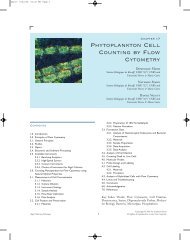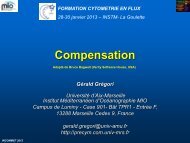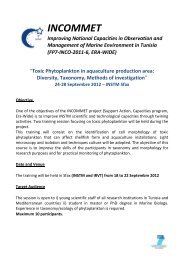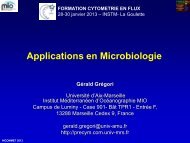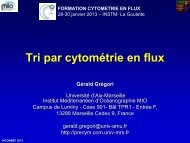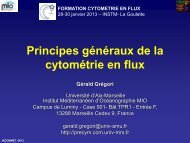Eukaryotic Picoplankton in Surface Oceans - incommet
Eukaryotic Picoplankton in Surface Oceans - incommet
Eukaryotic Picoplankton in Surface Oceans - incommet
Create successful ePaper yourself
Turn your PDF publications into a flip-book with our unique Google optimized e-Paper software.
Annu. Rev. Microbiol. 2011.65:91-110. Downloaded from www.annualreviews.org<br />
by CSIC - Consejo Superior de Investigaciones Cientificas on 09/27/11. For personal use only.<br />
MAST: mar<strong>in</strong>e<br />
stramenopiles<br />
Further studies demonstrate that the MALV<br />
clonal abundance severely overestimates cell<br />
abundance. MALV sequences decrease from<br />
39% <strong>in</strong> a rDNA library to 8% <strong>in</strong> a rRNA library<br />
likely because of the high rDNA copy<br />
number <strong>in</strong> alveolates and perhaps because of the<br />
presence of detrital DNA (59). FISH counts of<br />
MALV-II d<strong>in</strong>ospores <strong>in</strong> the Mediterranean Sea<br />
(77) are rather high <strong>in</strong> one coastal station (20%<br />
of eukaryotes) but low offshore (0.4%–3.1%).<br />
These moderate counts, accompanied with<br />
high prevalence (2%–10% <strong>in</strong>fected cells) and a<br />
wide range of host species, suggest that MALV<br />
may be important parasites. Indeed, parasitism<br />
emerges as an <strong>in</strong>teraction that can severely <strong>in</strong>fluence<br />
microbial food webs, community structure,<br />
and population dynamics (12).<br />
Stramenopiles: Chrysophytes,<br />
Pelagophytes, and MAST<br />
This supergroup accounts for 16% of sequences<br />
<strong>in</strong> our dataset (Figure 4). The stramenopile<br />
phylogenetic tree <strong>in</strong>cludes a large radiation<br />
of chloroplast-conta<strong>in</strong><strong>in</strong>g groups and a basal<br />
grade of heterotrophic groups. Diatoms, chrysophytes,<br />
pelagophytes, dictyochophytes, and<br />
bolidophytes are well represented <strong>in</strong> molecular<br />
surveys and could expla<strong>in</strong> mar<strong>in</strong>e PPE, because<br />
they all have picosized cultures (82). Indeed,<br />
environmental sequences are close to cultures,<br />
although new clades are also seen (19). From<br />
these groups, chrysophytes and pelagophytes<br />
appear as especially important PPE components<br />
as deduced from plastid 16S rDNA surveys<br />
(45), the expression of the photosynthetic<br />
gene psbA (53), rRNA libraries (59), FISH<br />
counts on cytometrically sorted cells (21% and<br />
26% of eukaryotes respectively; 36), and pigment<br />
analyses (42, 60). On the other hand, diatoms<br />
seem to contribute little to picoplankton.<br />
The same holds true for bolidophytes<br />
and dictyochophytes, although one study highlights<br />
these two groups as major cyanobacterial<br />
grazers (28).<br />
Stramenopile heterotrophic groups <strong>in</strong>clude<br />
parasites (such as pirsonids), osmotrophs (such<br />
as labyr<strong>in</strong>thulids), and bacterivores (such as bicosoecids),<br />
groups that are detected <strong>in</strong> molecular<br />
surveys (Figure 4). However, most sequences<br />
<strong>in</strong> this part of the tree form new<br />
clades named MAST (mar<strong>in</strong>e stramenopiles)<br />
(56). They account for 6% of sequences <strong>in</strong><br />
our survey, and 13% consider<strong>in</strong>g only studies<br />
analyz<strong>in</strong>g picoeukaryotes (Figure 4c). Moreover,<br />
MAST sequences are more represented<br />
<strong>in</strong> rRNA libraries, stress<strong>in</strong>g their putative activity<br />
(59). FISH results revealed that MAST<br />
cells from clades 1, 2, and 4 have a size of 2<br />
to 8 μm, lack chloroplasts, <strong>in</strong>gest bacteria, and<br />
are widely distributed <strong>in</strong> the sea, account<strong>in</strong>g for<br />
∼20% of heterotrophic flagellates (56). Each<br />
l<strong>in</strong>eage exhibits cells of different size and with a<br />
particular distribution. In addition, comb<strong>in</strong><strong>in</strong>g<br />
FISH with bacterivory experiments highlights<br />
functional diversity between clades, which vary<br />
<strong>in</strong> graz<strong>in</strong>g rates and prey spectra (57).<br />
Rhizaria: Cercozoans and Radiolarians<br />
Rhizaria <strong>in</strong>clude amoeboid protists with<strong>in</strong><br />
three ma<strong>in</strong> groups, cercozoa, radiolaria, and<br />
foram<strong>in</strong>ifera, with the first two well represented<br />
<strong>in</strong> molecular surveys (Figure 4). Cercozoan<br />
sequences fall with<strong>in</strong> flagellated cercomonads<br />
or with<strong>in</strong> the algal chlorarachniophytes. Both<br />
groups are plausible picoeukaryotes. Most<br />
rhizarian sequences (6%) affiliate with radiolaria,<br />
<strong>in</strong>clud<strong>in</strong>g the novel clades RAD A and<br />
RAD B. Radiolarian sequences are even more<br />
prevalent <strong>in</strong> subsurface and deep samples (60).<br />
This clonal abundance is a current enigma,<br />
because known radiolarians are typically<br />
microplankters. Some sequences could derive<br />
from small swarmers released as reproductive<br />
stages, and others from detrital or dissolved<br />
DNA. The clonal share of radiolaria is severely<br />
reduced (from 39% to 3%) when construct<strong>in</strong>g<br />
rDNA and rRNA libraries from the same<br />
sample (59), highlight<strong>in</strong>g the overestimation<br />
of rDNA surveys. Further research is needed<br />
to resolve the picoradiolaria enigma.<br />
Archaeplastida: Pras<strong>in</strong>ophytes<br />
This supergroup of obliged phototrophs <strong>in</strong>cludes<br />
red algae, glaucophytes, and green algae<br />
plus land plants. Only pras<strong>in</strong>ophytes (green algae)<br />
are important <strong>in</strong> molecular surveys, with<br />
100 Massana



